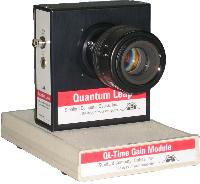Image Intensifier Module Family: Quantum Leap
Upgrate your setup to full-fledged intensified imaging
Highlights
|
|
| Quantum Leap Brochure |
Technical drawing |
High speed video camera Adaptive optics solution Rotating mirror camera Hypervelocity impact Synchrotron radiation diagnostic |
Overview
Quantum Leap is a stand alone image intensifier module, which upgrades your existing setup to a full-fledged intensified imaging system. The Quantum Leap is available as non-gateable or gateable version, where the gateable Quantum Leap is available with minimal gate time of 1.2ns or 0.2ns. The compact design of all Quantum Leap models hosts everything needed for operation. Only a 12V electrical power supply and a RS232 conection for gateable models is necessary.
Compact image intensifier module
Due to it's compact design all Quantum Leap models can rapidly be mounted to any detector with C-mount camera. As a result of its compact design and the intuitive handling the Quantum Leap is used in many scientific fields and for the most advanced scientific applications.
Highest flexibility with Time & Gain Module
As standard the gateable Quantum Leap enables the external gating. Therefor, the image intensifier is open whenever a low TTL signal is applied to the external gating connector. The Time/Gate module provides a digital access to the Quantum Leap and the ability of remote configuration of the delay and gating time.
Find a detailed description of the image intensifier technique at the technology section. For further information about the Quantum Leap family please get in touch with our sales manager or read the Quantum Leap data sheet.
Technical Details
Parameter |
Quantum Leap N | Quantum Leap E | |
| Gating time | 1.2ns ... 80s | 0.2ns ... 80s | |
| Delay time | 100ps ... 80s | 10ps ... 80s | |
| Adjustable time step size | 100ps | 10ps | |
| Jitter | <20ps | <10ps | |
| Gating control | TTL pulse (standard); remote with Time/Gain module (optional) |
||
| Gate repetition rate | up to 3.3MHz (burst mode); up to 100kHz (continuous mode, standard) |
||
| Trigger propagation delay | external gate pulse: 30-35ns; internal gate pulse: 60-65ns (with Time & Gain Module) |
||
| MCP voltage gain | software controlled via Time & Gain module optional: manually with potentiometer |
||
| Optical input | standard: C-mount, optional: F-mount or others | ||
| Optical input window | quartz | ||
| Image intensifier type | standard: single stage, optional: dual stage | ||
| Image intensifier | 18mm diameter |
||
| Input image area | ⌀ 18mm: 14.4 x 10.8mm (field of view) | ||
| Photocathode | standard: high QE UV optional: high QE blue, high QE red |
||
| Spectral sensitivity | UV - NIR, depending on the Photocathode | ||
| Phosphor screen | standard: P43, optional: P46 | ||
| Coupling lens | magnification 1:2.25 customized coupling lens |
||
| Optical output | C-mount | ||
| Dimensions | 60 x 236 x 150mm (Time & Gain Module: 240 x 140 x 40mm) | ||
| Module weight | 1.8kg (Time & Gain Module: 0.3kg) | ||
| Module mount | 1/4" x 20 and M8 mounting hole at the bottom of the module | ||
| Power Supply | 12V ±5% | ||
Publications
| Author | Institution | Year | Title |
| C.R. Howle et al. | Defence Science and Technology Laboratory | 2008 | |
| K.S. Lee, et al. |
Korea Advanced Institute of Science and Technology |
2005 |
The dynamics of Br (P) formation in the photodissociation of vinyl and perfluorovinyl bromides |
| D.L. McKenna et al. | University of Arizona | 2003 | |
| D.L. McKenna, et al. | Large Binocular Telescope (LBT) | 2003 | |
| H.S. Chung, et al. | Seoul National University | 2001 |
Molecular lens applied to benzene and carbon disulfide molecular beams |

